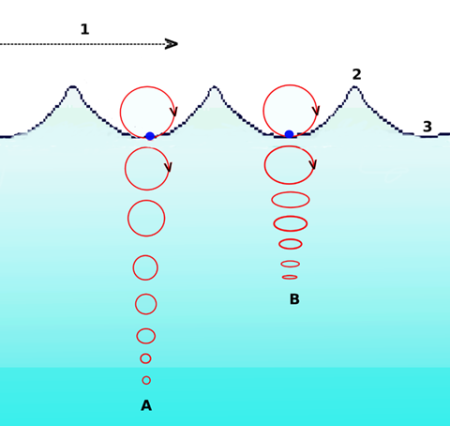- Science
- Grade 4
- Force, motion, and energy

Knowledge and Skills Statement
The further explanation is designed to be a resource for educators that helps them better understand the topic their students are learning. Further explanations may be written at a more complex level than would be expected for students at the grade level.
Waves in water:
The particles involved in waves move back and forth perpendicularly to the way the wave is going, but don’t move significantly in the direction of the wave. In the image shown here, the circles represent the movement of particles in deep water (A) and shallow water (B). The particles are moving up and down while the wave is moving to the right (1). The particles ‘take part’ in the wave by bumping into one another and transferring energy. This is why energy can be transferred, even though the average position of the particles doesn’t change.
Research
Kolb, Jennifer. “Hunting for Energy.” Science and Children 47, no. 4 (December 2009): 42–44. https://www.proquest.com/docview/236912040?pq-.origsite=gscholar&fromopenview=true&sourcetype=Scholarly%20Journals
Summary: Students in this article identify different types of energy and how energy can be transferred. Teachers should start by identifying what students already know about energy and what misconceptions they already have. Students should understand that energy is all around us and can be easily observed. The teacher in this article had students walk the school looking for different energy forms. Students could easily identify items like televisions and lights as having energy but struggled to identify heat and light energy forms. Students also assumed that any object that moved must have energy. As a class, students then classified types of energy. Students then worked in pairs to identify and classify energy by type. After students easily identified different forms of energy, they discussed how energy is transferred. When this happens, the energy is only changed but not lost. The teacher used a lamp as an example where the energy changes from electrical to heat and light.

